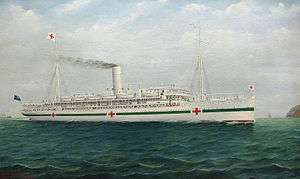SS Marama
The SS Marama was an ocean liner belonging to the Union Company of New Zealand from 1907 to 1937. It was a hospital ship in WWI as His Majesty's New Zealand Hospital Ship No. 2.
 SS Marama serving as a hospital ship, 1915 | |
| History | |
|---|---|
| Name: | SS Marama |
| Owner: | Union Company, Dunedin |
| Port of registry: | Wellington |
| Route: | New Zealand — Australia & Trans-Pacific |
| Builder: | Caird & Company, Greenock |
| Cost: | £166,000 |
| Yard number: | 313 |
| Launched: | 1907 |
| In service: | November 1907 |
| Out of service: | 1937 |
| Identification: | Official number: 117,597 |
| Fate: | Broken up, |
| General characteristics | |
| Type: | Ocean liner |
| Tonnage: | |
| Length: | 420 ft (130 m) |
| Beam: | 53.2 ft (16.2 m) |
| Depth: | 31.2 ft (9.5 m) |
| Speed: | 17 knots (31 km/h; 20 mph) |
| Capacity: |
|
| Crew: | 140 |
History
Built by Caird & Company at Greenock at a cost of £166,000 ($332,000), the SS Marama arrived at Port Chalmers in November 1907. It was the largest and most powerful ship (though not the fastest) in the USS Co fleet. Initially, it sailed on the Horseshoe run to Australia, and occasionally in trans-Pacific services. After war service, it was refitted (1920) for the trans-Pacific services to San Francisco or Vancouver. In 1925, it was converted to burn oil, and employed on the Tasman run.
The ship was sold to Shanghai shipbreakers the Linghua Dock & Engineering Works Ltd in 1937, then resold to Kobe shipbreakers Miyachi K.K.K. (who had also purchased the Maheno) and was broken up at their Osaka shipyard in 1938.
Marama Hall at the University of Otago is named after the liner, commemorating medical personnel who served aboard the two New Zealand hospital ships in World War I.[1]
See also
- SS Maheno: sister ship; His Majesty's New Zealand Hospital Ship No. 1.
References
- "Marama Hall". New Zealand Military Nursing. Retrieved 2 October 2019.
- McLean, Gavin (2013). The White Ships: New Zealand’s First World War Hospital Ships. Wellington: New Zealand Ship and Marine Society. pp. 100, 185. ISBN 978-0-473-24977-9.
- McLauchlan, Gordon (1987). The Line that Dared: A history of the Union Steam Ship Company 1875-1975. Auckland: Four Star Books. pp. 52, 53. ISBN 0-9597853-0-2.
- "SS Maheno & SS Marama". SSMaritime. 2015.
- "Photo of NZ Hospital Ship Marama". NZETCe= 2015.
- "SS Marama on trial on Clyde (photo)". Otago Witness (Papers Past). 13 November 1907.
- "Captain Gibb, officers and passengers on Marama (photo)". Otago Witness (Papers Past). 13 November 1907.
- "SS Marama at Dunedin wharf (photo)". Otago Witness (Papers Past). 13 November 1907.